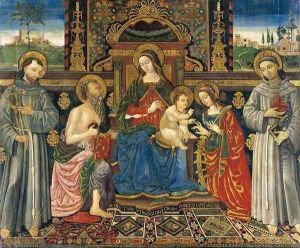Francesco Di Gabriele Da Viterbo Paintings
Francesco di Gabriele da Viterbo, also known as Francesco d'Antonio or Francesco di Viterbo, was an Italian painter active during the late 15th and early 16th centuries, primarily in the region of Umbria and in his native city of Viterbo. His exact birth and death dates are not firmly established, but he is believed to have been born around 1445 and to have died around 1516.
Francesco's work is characterized by the influence of the Umbrian school of painting, which in turn was heavily influenced by the works of Pietro Perugino and Luca Signorelli. Francesco's paintings often exhibit a delicate use of color and a serene, devotional character typical of the Umbrian style. During his lifetime, he collaborated with other artists and was also influenced by the Florentine artistic milieu, which included artists such as Filippo Lippi and Domenico Ghirlandaio.
Not much is known about Francesco's training or early career, but it is likely that he trained with local artists in Viterbo before venturing to other cities to further his career. His works include altarpieces, frescoes, and panel paintings for churches and convents, many of which have survived to the present day. Some of his notable works include the 'Madonna and Child with Angels' and a fresco cycle in the Palazzo dei Priori in Viterbo.
Despite his considerable talent, Francesco di Gabriele da Viterbo remains a relatively obscure figure in art history, with much of his life and work still requiring further research. His contributions to the Umbrian school, however, reflect the broader artistic developments occurring in Italy during the Renaissance, a period marked by a renewed interest in classical antiquity, the development of perspective, and a focus on the human figure and the natural world.
